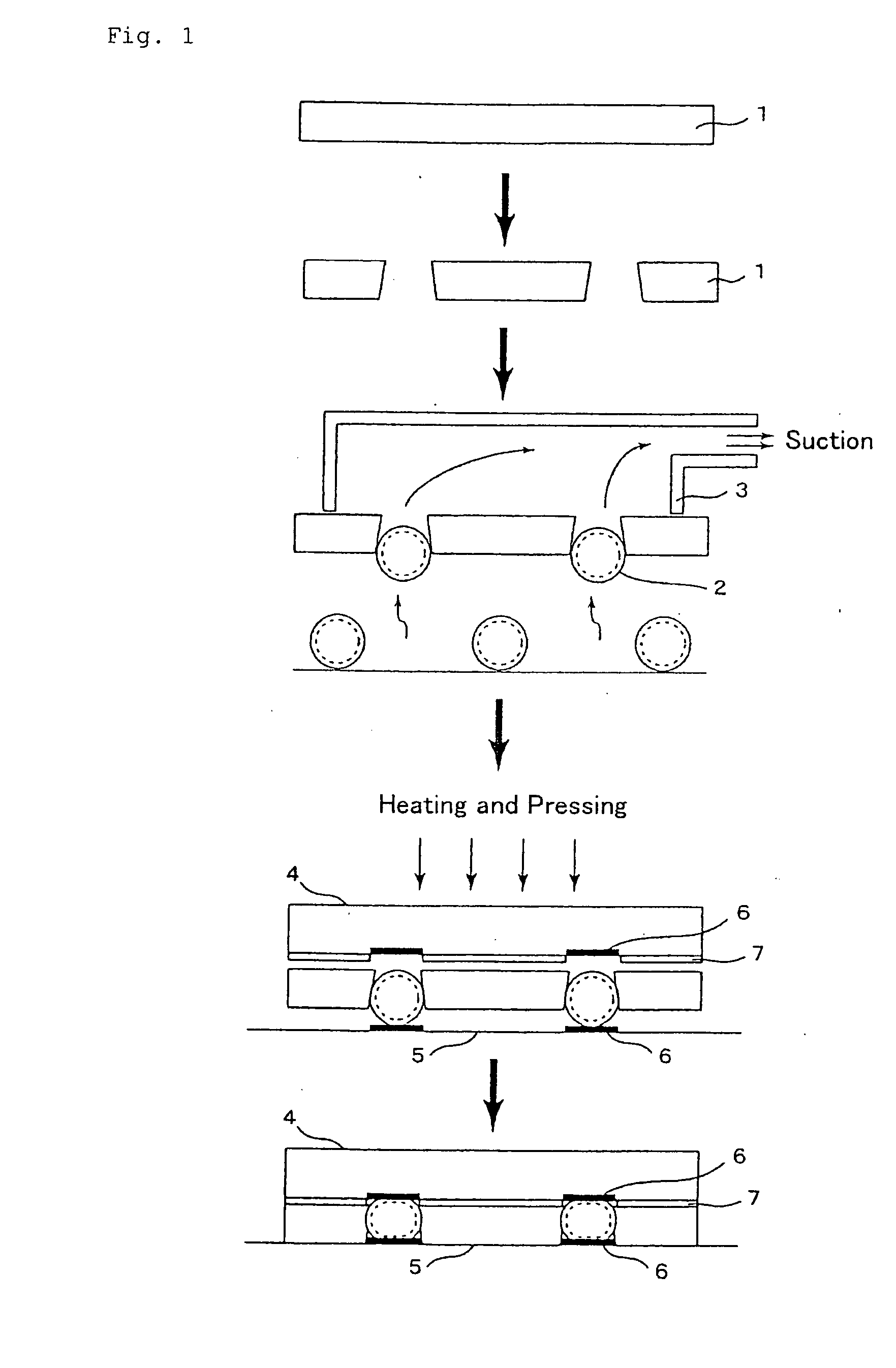Microparticle arrangement film, electrical connection film, electrical connection structure, and microparticle arrangement method
a technology of microparticles and adhesives, applied in the direction of coupling device connections, sustainable manufacturing/processing, final product manufacturing, etc., can solve the problems of poor dispersing efficiency, leakage at neighbor electrodes, and difficulty in uniformly pouring sealing resin in a short tim
- Summary
- Abstract
- Description
- Claims
- Application Information
AI Technical Summary
Benefits of technology
Problems solved by technology
Method used
Image
Examples
example 2
[0104] Fine particles of polystyrene of average diameter: 250 .mu.m, aspect ratio: 1.15 and CV value: 4% were prepared. Further, the polyimide film of Young's modulus: 6 GPa, thickness: 180 .mu.m and size: 2 cm.times.2 cm was formed with 32 holes to be square shaped at 0.5 mm pitch via the CO.sub.2 laser, such that the holes of CV value: 6% and aspect ratio: 1.25 would be shaped in taper of 220 .mu.m on the front side and 190 .mu.m on the back side of the film. By using the CO.sub.2 laser, the desired dimensions and shapes could be precisely formed. At the back side of the film, the suction openings of 7 mm diameter were attached such that all holes of film were covered and any leakage was not to be caused, and fine particles were sucked as the suction opening coming near to fine particles while sucked at the degree of vacuum of -30 kPa. Although particles of minute amount escaped to the vacuum side and particles of minute amount were adhered, they could be removed by as light air p...
example 3
[0106] Divinylbenzene based copolymer obtained by seed polymerization was classified by screening and a wet-classification into fine globes. Then, a nickel layer of 0.2 .mu.m thickness was formed onto the fine gloves by an electroless plating, and further a gold layer of 2.3 .mu.m thickness was formed by an electroplating. Particles thereof were further classified into metal-coated fine globes of average diameter: 75 .mu.m, aspect ratio: 1.03, CV value: 1%, K value: 4000 N / mm.sup.2, recover rate: 60%, coefficient of linear expansion at normal temperature: 50 ppm, and resistant value: 0.01 .OMEGA.. Further, the half-cured epoxy based film of Young's modulus: 0.4 GPa, thickness: 68 .mu.m and size: 1 cm.times.1 cm was formed via the CO.sub.2 laser with 18 holes in two rows of about 3 mm-separation at about 300 .mu.m pitches such that the holes would agree in position with the electrodes of IC chips, and formed via the CO.sub.2 laser to be CV value: 2% and aspect ratio: 1.04, and shaped...
example 4
[0111] On the fine globes of the methyl methacryl based cross-linking copolymer, the nickel layer of 0.1 .mu.m thickness was formed by an electroless plating, and further a gold layer of 0.9 .mu.m thickness was formed by an electroplating. Particles thereof were classified into metal-coated fine globes of average diameter: 45 .mu.m, aspect ratio: 1.05, CV value: 2%, K value: 2000 N / mm.sup.2, recover rate: 50%, coefficient of linear expansion at normal temperature: 80 ppm, and resistant value: 0.03 .OMEGA.. Further, the half-cured glass-epoxy based film of Young's modulus: 2 GPa, thickness: 60 .mu.m and size: 1 cm.times.1 cm was formed via the excimer laser with 16 holes in two rows of about 2 mm-separation at 150 .mu.m pitches, such that the holes would agree in position with the electrodes of IC chips, formed via the excimer laser to be CV value: 2% and aspect ratio: 1.05, and shaped in taper of 43 .mu.m on the front side and 38 .mu.m on the back side of the film. By using the exci...
PUM
 Login to View More
Login to View More Abstract
Description
Claims
Application Information
 Login to View More
Login to View More - R&D
- Intellectual Property
- Life Sciences
- Materials
- Tech Scout
- Unparalleled Data Quality
- Higher Quality Content
- 60% Fewer Hallucinations
Browse by: Latest US Patents, China's latest patents, Technical Efficacy Thesaurus, Application Domain, Technology Topic, Popular Technical Reports.
© 2025 PatSnap. All rights reserved.Legal|Privacy policy|Modern Slavery Act Transparency Statement|Sitemap|About US| Contact US: help@patsnap.com


